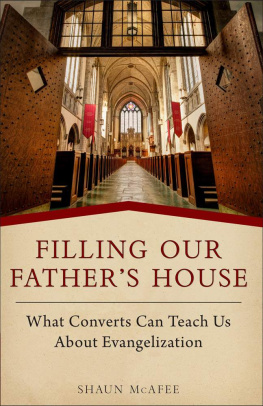Shaun McAfee - 20 Answers: Relics & Sacramentals
Here you can read online Shaun McAfee - 20 Answers: Relics & Sacramentals full text of the book (entire story) in english for free. Download pdf and epub, get meaning, cover and reviews about this ebook. year: 2021, publisher: Catholic Answers Press, genre: Religion. Description of the work, (preface) as well as reviews are available. Best literature library LitArk.com created for fans of good reading and offers a wide selection of genres:
Romance novel
Science fiction
Adventure
Detective
Science
History
Home and family
Prose
Art
Politics
Computer
Non-fiction
Religion
Business
Children
Humor
Choose a favorite category and find really read worthwhile books. Enjoy immersion in the world of imagination, feel the emotions of the characters or learn something new for yourself, make an fascinating discovery.

- Book:20 Answers: Relics & Sacramentals
- Author:
- Publisher:Catholic Answers Press
- Genre:
- Year:2021
- Rating:5 / 5
- Favourites:Add to favourites
- Your mark:
- 100
- 1
- 2
- 3
- 4
- 5
20 Answers: Relics & Sacramentals: summary, description and annotation
We offer to read an annotation, description, summary or preface (depends on what the author of the book "20 Answers: Relics & Sacramentals" wrote himself). If you haven't found the necessary information about the book — write in the comments, we will try to find it.
Shaun McAfee: author's other books
Who wrote 20 Answers: Relics & Sacramentals? Find out the surname, the name of the author of the book and a list of all author's works by series.
20 Answers: Relics & Sacramentals — read online for free the complete book (whole text) full work
Below is the text of the book, divided by pages. System saving the place of the last page read, allows you to conveniently read the book "20 Answers: Relics & Sacramentals" online for free, without having to search again every time where you left off. Put a bookmark, and you can go to the page where you finished reading at any time.
Font size:
Interval:
Bookmark:
20 Answers
g
Relics & Sacramentals
Shaun McAfee

20 Answers: Relics & Sacramentals
Shaun McAfee
2021 Catholic Answers
All rights reserved. Except for quotations, no part of this book may be reproduced or transmitted in any form or by any means, electronic or mechanical, including photocopying, recording, uploading to the internet, or by any information storage and retrieval system, without written permission from the publisher.
Published by Catholic Answers, Inc.
2020 Gillespie Way
El Cajon, California 92020
1-888-291-8000 orders
619-387-0042 fax
catholic.com
Printed in the United States of America
978-1-68357-239-8
978-1-68357-240-4 Kindle
978-1-68357-241-1 ePub
Introduction
I recall the first time a non-Catholic friend asked me, Why is Jesus still hanging on your cross? Shouldnt the cross be a sign of victory? The same person told me bluntly, Your priests bow to and kiss relics, but mine worship God with their whole heart.
Catholics have always had to defend sacramentals and relics from attacks on the Church. History tells that pagan kings would use sacred relics as items of mockery if they overthrew a Christian city. In the Middle Ages, con artists would counterfeit saints blessed vestments and other relics for profit. The Protestant Reformation attacked many of the Churchs sacraments, eroding peoples respect for and recognition of sacramentals in the process. The modern Church, too, has to defend sacred relics against the religion of science, whose adherents dismiss as superstition whatever they cant measure to their satisfaction in the here and now.
It doesnt help that at times, the same people who should have safeguarded the Churchs store of sacred relics instead gravely abused them. Catholics today have to work harder than ever to defend common sacramentalsthe crucifix, holy water, pieces of the True Cross, and all the rest.
To prevail on these theological and historical battlegrounds, present-day Catholics must arm themselves with a solid defense. The non-Catholics in our lives are not inclined to appreciate the material externals of our faith. And in our hyper-scientific age, in which unbounded skepticism has seeped into the culture, even ardent believers might be tempted to give up their faith in relics.
This booklet will help the cause by exploring the basis of the Catholic teaching on sacramentals and relics, providing a defense to a handful of the assumptions and misconceptions about these crucial pieces of our faith.
1.What is a sacramental?
The 1983 Code of Canon Law (CIC) defines sacramentals as sacred signs by which effects, especially spiritual effects, are signified in some imitation of the sacraments and are obtained through the intercession of the Church (1166). The Second Vatican Councils Constitution on the Sacred Liturgy, Sacrosanctum Concilium (SC), further describes sacramentals by their ability to signify effects, particularly of a spiritual nature, which are obtained through the intercession of the Church. By them men are disposed to receive the chief effect of the sacraments, and various occasions in life are rendered holy (60). Ordinarily, the person in charge of saying, making, or administering sacramentals is a cleric whom the Church has provided with the requisite power to do so (CIC 1168), and the Apostolic See alone can establish new sacramentals, authentically interpret those already received, or abolish or change any of them (1167, 1).
If this definition seems broad, thats because the world of sacramentals is equally broad. There is hardly any proper use of material things which cannot... be directed toward the sanctification of men and the praise of God (SC 61). Sacramentals come in diverse shapes and sizes, materials and substances, gestures and acts of piety, which is why the Church correctly describes them as signs. A few familiar examples of sacramentals are crucifixes, rosaries, candles, scapulars, holy water, anointing oils, and the sign of the cross.
There are some distinctions to help Catholics better understand the many types, forms, and purposes of sacramentals. The simplest method can be to divide them into things and acts : sacramentals we can hold in our hands and use and sacramentals we perform.
Theologians have further separated sacramentals into six groups based on purpose: o rans for public prayer, liturgical or private , such as chanting; tinctus , the application of holy water or oils (unctions); edens , blessing of foods; confessus , the general avowal of faults recited at Mass, Communion, and the Divine Office; dans , better known as alms; and benedicens , papal and episcopal blessings of items such as candles, salt, ashes, and palms.
The Catechism of the Catholic Church (CCC) has identified three distinctions among sacramentals: blessings, exorcisms, and forms of piety and devotions.
The Church prioritizes the sacramental of blessings, which includes people, food and meals, objects, and places. The act of blessing coincides with the Lords power to make all things new and for his purposes. Therefore, when a priest or deacon gives a blessing, he is renewing whatever he blesses as a consecration to God. When a bishop dedicates a new church, or a priest blesses a new chalice for use in the Mass, he is consecratingreservingthe object for a liturgical use. Similarly, when a blessing is invoked over a meal, the special intention of praise and thanksgiving to God for the nutrition is reflective of the eucharistic meal and the heavenly banquet.
Some might be surprised to hear that exorcisms are also sacramentals. They are functionally and effectively different from blessings. In an exorcism, the Church asks publicly and authoritatively in the name of Jesus Christ that a person or object be protected against the power of the evil one and withdrawn from his dominion (CCC 1673). To put it plainly, exorcisms are directed at expelling demons and liberating persons, objects, and places from demonic possession through the power Christ invested in the Church (Mark 6:7). A simple exorcism is given with baptism (three exorcisms occur in a baptism in the Extraordinary Form), and a major exorcism may be administered by a trained priest, in strict compliance with the Churchs rules, with a bishops approval.
Forms of piety and devotion are tremendously important to the life of a Catholicnot because they replace the liturgy, but because they extend it . These are sacramentals that belong to religious and the laity, such as the full brown scapular of a Carmelite nun or the small brown scapular worn by pious lay Catholics. In this category, we also find the vast majority of recognizable devotions and items belonging to these such as the stations of the cross, the crucifix, and the rosary. Forms of devotion also include genuflections (as one performs prior to entering a pew) and bowing at the head or waist. Answer 6 will cover the most common forms of devotion in further detail.
Sacraments and sacramentals share a similar name, but the two are distinguished by their unique respective roles in the life of the Church. Whereas sacraments are the efficacious sign of grace, sacramentals bear resemblance to the sacraments. They prepare mankind to receive the fruit of the sacraments and sanctify different circumstances of life.
2. Is there a biblical or historical basis for sacramentals?
Those searching the Bible to prove Catholics wrong on the use of sacramentals will point to the absence of items like rosaries, miraculous medals, and scapulars. In most of Scripture, sacraments had not been established, or the apostles did not fully understand them. But many examples of sacramentals do in fact exist in the Bible, prefiguring the sacraments.
Next pageFont size:
Interval:
Bookmark:
Similar books «20 Answers: Relics & Sacramentals»
Look at similar books to 20 Answers: Relics & Sacramentals. We have selected literature similar in name and meaning in the hope of providing readers with more options to find new, interesting, not yet read works.
Discussion, reviews of the book 20 Answers: Relics & Sacramentals and just readers' own opinions. Leave your comments, write what you think about the work, its meaning or the main characters. Specify what exactly you liked and what you didn't like, and why you think so.








